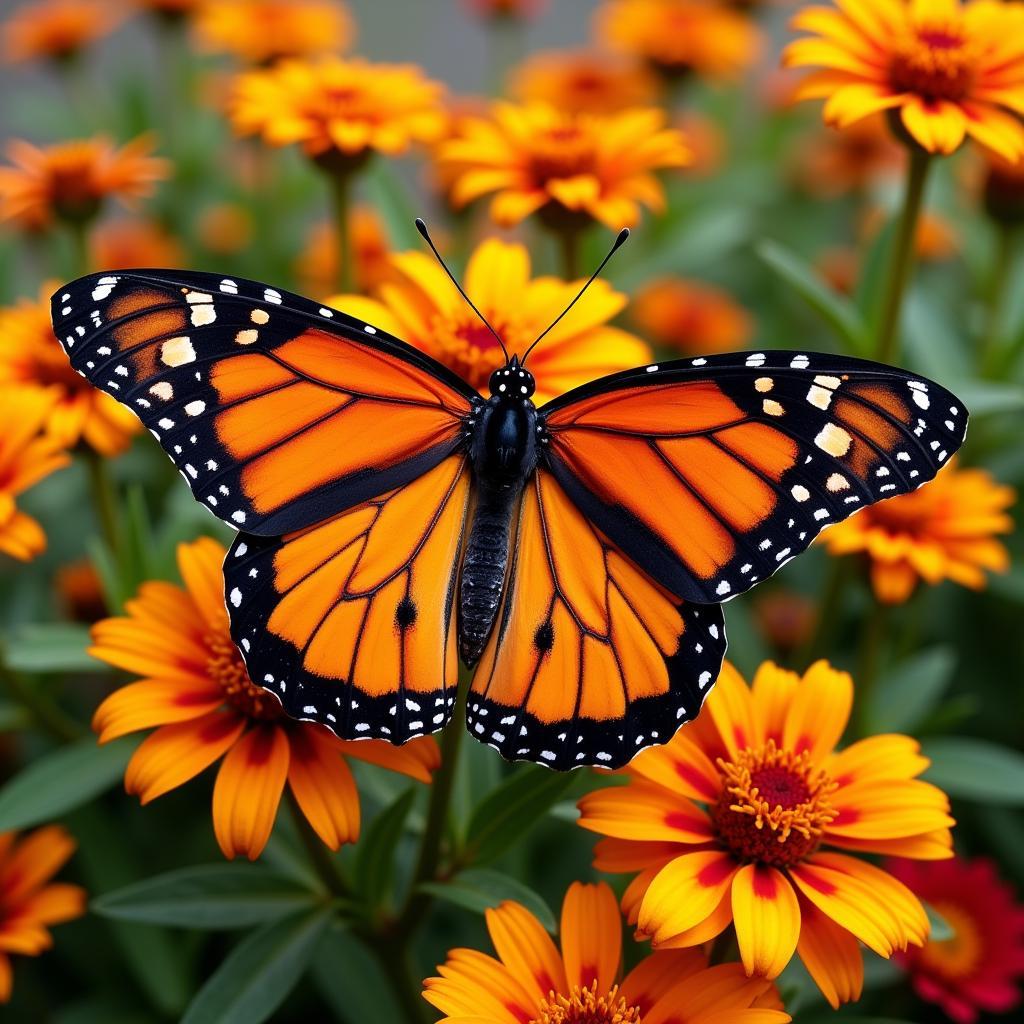Have you ever been mesmerized by the vibrant colors fluttering around a garden? Butterflies, with their intricate patterns and dazzling hues, seem like living works of art. But their beauty is more than just a visual treat. Those bright colors serve several important purposes, crucial to their survival and the continuation of their species. Let’s delve into the fascinating world of butterflies and uncover the secrets behind their vibrant appearances.
Camouflage and Warning Signals: A Colorful Defense Mechanism
One of the primary reasons for a butterfly’s bright colors is camouflage. While this might seem counterintuitive at first, consider the environment they inhabit. Butterflies are often found amidst brightly colored flowers and lush green foliage. Their intricate patterns and vibrant colors help them blend seamlessly into these surroundings, making it harder for predators like birds and reptiles to spot them.
 Butterfly Camouflaged Among Flowers
Butterfly Camouflaged Among Flowers
However, some butterflies take a bolder approach, sporting warning colors. These butterflies, often adorned with bright shades of red, orange, yellow, or even blue, advertise their toxicity to potential predators. This striking coloration serves as a deterrent, signaling to predators that they are poisonous or distasteful. The monarch butterfly, with its iconic orange and black wings, is a prime example of this strategy.
The Language of Love: Attracting Mates
Beyond protection, bright colors play a crucial role in butterfly courtship. Just like humans are drawn to certain physical attributes, butterflies rely on visual cues to find suitable mates. The males often sport the most vibrant and eye-catching colors, using them to attract the attention of females. These colors act as signals, conveying information about the male’s species, health, and genetic fitness.
For example, the male peacock butterfly has iridescent blue spots on its wings that shimmer and change color in the sunlight. This dazzling display is designed to impress females and outshine competitors.
 Male Butterfly Displaying Wings to Female
Male Butterfly Displaying Wings to Female
Reflecting Sunlight: Thermoregulation
Believe it or not, a butterfly’s bright colors also help it regulate its body temperature. Butterflies are cold-blooded creatures, meaning they rely on external sources to regulate their internal temperature. The dark pigments in their wings absorb heat from sunlight, allowing them to warm up quickly and maintain optimal body temperature for flight and other activities. Conversely, lighter colors reflect sunlight, preventing them from overheating in hot weather.
The Science of Color: Pigments and Structural Color
The vibrant colors we see in butterfly wings are produced by two main mechanisms: pigments and structural color. Pigments are chemical compounds that absorb certain wavelengths of light and reflect others, producing specific colors. Melanin, for example, is a common pigment found in butterfly wings, responsible for shades of black, brown, and orange.
Structural color, on the other hand, is produced by the physical structure of the butterfly’s wings. The wings are covered in tiny scales, each containing intricate ridges and grooves that interact with light waves. These structures scatter light in specific ways, creating iridescent and shimmering effects that change depending on the angle of view.
The Ever-Evolving Palette: Adaptation and Evolution
The colors of butterflies are a testament to the power of evolution. Over millions of years, butterflies have evolved a dazzling array of colors and patterns, each serving a specific purpose in their survival and reproduction. As their environments changed, so did their colors, adapting to new predators, food sources, and mating rituals.
The study of butterfly coloration provides valuable insights into the intricate relationship between evolution, adaptation, and the natural world. It’s a reminder that even the smallest and seemingly insignificant creatures can possess extraordinary beauty and complexity.
Conclusion
So, why do butterflies have bright colors? The answer is multifaceted, encompassing camouflage, warning signals, mate attraction, and even thermoregulation. Their vibrant hues are not merely decorative but serve crucial roles in their survival and reproduction. Next time you encounter a butterfly, take a moment to appreciate the intricate beauty of its wings and the fascinating evolutionary journey it represents.
Do you want to learn more about the wonders of the natural world? Check out these related articles:
Let’s continue exploring the beauty and wonder of the world around us!

